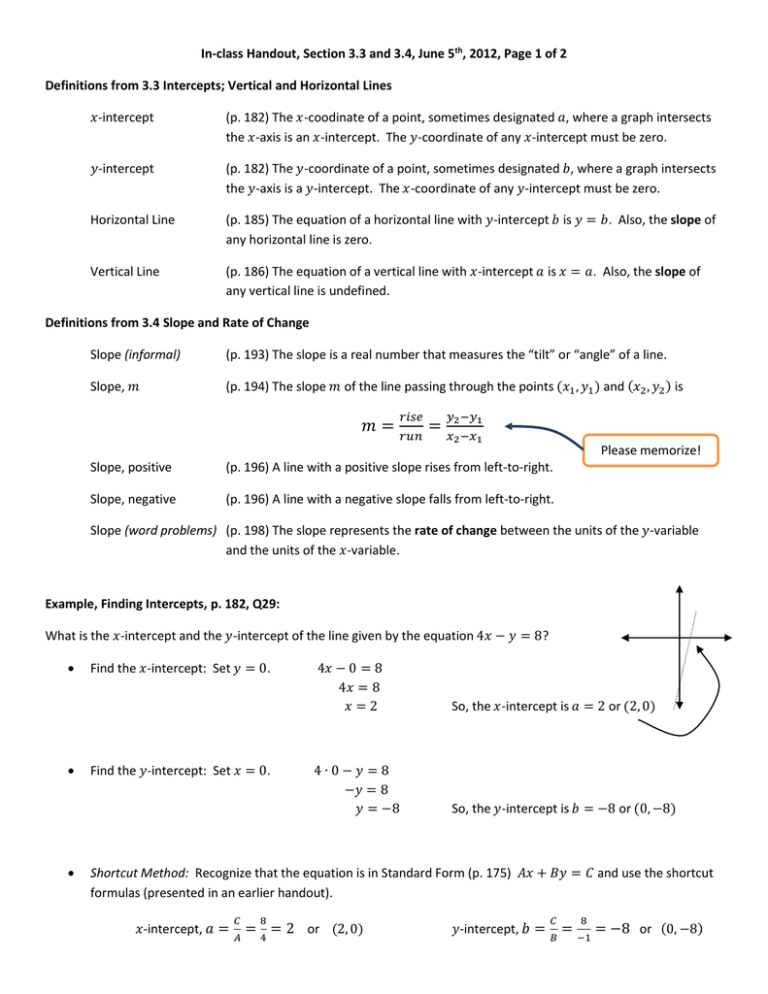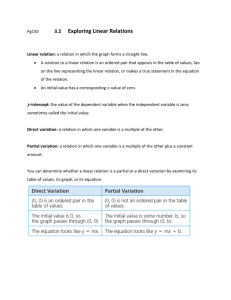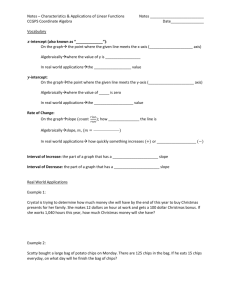In-class Handout, Section 3.3 and 3.4, June 5th, 2012, Page 1 of 2
advertisement

In-class Handout, Section 3.3 and 3.4, June 5th, 2012, Page 1 of 2 Definitions from 3.3 Intercepts; Vertical and Horizontal Lines 𝑥-intercept (p. 182) The 𝑥-coodinate of a point, sometimes designated 𝑎, where a graph intersects the 𝑥-axis is an 𝑥-intercept. The 𝑦-coordinate of any 𝑥-intercept must be zero. 𝑦-intercept (p. 182) The 𝑦-coordinate of a point, sometimes designated 𝑏, where a graph intersects the 𝑦-axis is a 𝑦-intercept. The 𝑥-coordinate of any 𝑦-intercept must be zero. Horizontal Line (p. 185) The equation of a horizontal line with 𝑦-intercept 𝑏 is 𝑦 = 𝑏. Also, the slope of any horizontal line is zero. Vertical Line (p. 186) The equation of a vertical line with 𝑥-intercept 𝑎 is 𝑥 = 𝑎. Also, the slope of any vertical line is undefined. Definitions from 3.4 Slope and Rate of Change Slope (informal) (p. 193) The slope is a real number that measures the “tilt” or “angle” of a line. Slope, 𝑚 (p. 194) The slope 𝑚 of the line passing through the points (𝑥1 , 𝑦1 ) and (𝑥2 , 𝑦2 ) is 𝑚= 𝑟𝑖𝑠𝑒 𝑟𝑢𝑛 = 𝑦2 −𝑦1 𝑥2 −𝑥1 Please memorize! Slope, positive (p. 196) A line with a positive slope rises from left-to-right. Slope, negative (p. 196) A line with a negative slope falls from left-to-right. Slope (word problems) (p. 198) The slope represents the rate of change between the units of the 𝑦-variable and the units of the 𝑥-variable. Example, Finding Intercepts, p. 182, Q29: What is the 𝑥-intercept and the 𝑦-intercept of the line given by the equation 4𝑥 − 𝑦 = 8? Find the 𝑥-intercept: Set 𝑦 = 0. Find the 𝑦-intercept: Set 𝑥 = 0. 4𝑥 − 0 = 8 4𝑥 = 8 𝑥=2 So, the 𝑥-intercept is 𝑎 = 2 or (2, 0) 4∙0−𝑦 =8 −𝑦 = 8 𝑦 = −8 So, the 𝑦-intercept is 𝑏 = −8 or (0, −8) Shortcut Method: Recognize that the equation is in Standard Form (p. 175) 𝐴𝑥 + 𝐵𝑦 = 𝐶 and use the shortcut formulas (presented in an earlier handout). 𝑥-intercept, 𝑎 = 𝐶 𝐴 8 = 4 = 2 or (2, 0) 𝑦-intercept, 𝑏 = 𝐶 𝐵 8 = −1 = −8 or (0, −8) Examples, Graphing Horizontal and Vertical Lines, p. 185, p. 186: A) Graph the equation 𝑦 = −3. If we were graphing this on a number line, the result might look like: However, on an 𝑥𝑦-plane the equation 𝑦 = −3 has a different look (see below): -3 𝑦-axis Why is the graph a point on a number line but a line in the 2D 𝑥𝑦-plane? One explanation is that the line represents all solutions to the equation 𝑦 = −3. Every point on the line has a 𝑦-coordinate of −3 and this is enough to be a solution to the given equation 𝑦 = −3. 5 𝑦-axis 4 3 2 1 𝑥-axis 0 -5 -4 -3 -2 -1 0 1 2 3 4 5 -1 -2 𝑦 = −3 -3 -4 -5 B) Graph the equation 𝑥 = −2. If you recognize that an equation is missing a variable, in this case 𝑦, this means you can set the missing variable to any value. The one constant is that 𝑥 = −2 no matter what the value of 𝑦 is. Using a table: 𝒙 𝒚 −2 0 −2 1 −2 2 Graphing these points should result in a vertical line (left to the student to graph). −2 3 In-class Handout, Section 3.3 and 3.4, June 5th, 2012, Page 2 of 2 Example, Calculating the Slope, p. 194 Calculate the slope of a line passing through the points (−3, 2) and (2, −1). One method would be the sketch these two points and use the formula 𝑚 = 𝑅𝑖𝑠𝑒 . 𝑅𝑢𝑛 The disadvantages of this method are that a sketch may be inaccurate and if your problem has fractions or decimals then it will be more difficult to get an accurate result. 𝑚= The preferred method is to use the formula o First, label your points: Then, plug these values into the formula: 𝑦2 −𝑦1 𝑥2 −𝑥1 (−3, 2) 𝑥1 𝑦1 𝑚= . Summarizing, the slope of this line is (2, −1) 𝑥2 𝑦2 𝑦2 − 𝑦1 −1 − 2 3 = =− 𝑥2 − 𝑥1 2 − (−3) 5 𝑚=− 3 5 Example, Calculating the Slope from a Graph, p. 196 What is the slope of the line in the graph? 5 4 3 2 1 Look for perfect intersections through the grid. 0 -5 -4 -3 Rise -2 -1 0 1 2 3 4 5 -1 -2 -3 Run -4 -5 Either write the coordinates of two points and use the method of the previous example. Or use 𝑚 = 𝑅𝑖𝑠𝑒 𝑅𝑢𝑛 = −4 . 5 Example, Sketch a Line with a Given Slope, p. 197 Sketch a line with the slope 𝑚 = 2 that passes through the point (−1, −1). The slope cannot be used until we graph the point. So the first step is to graph the point. From this point, we can use the slope 𝑚 = 1. Rise positive 2 (go up) and Run positive 1 (go right). Alternatively, we can Rise negative 2 (go down) and Run negative 1 (go left) since 𝑚 = 1 = −1 2 2 −2 5 4 3 2 1 0 -5 -4 -3 -2 -1 0 1 2 3 4 5 -1 -2 -3 -4 -5 (finish the sketch) Example, Recognizing the Slope in a Word Problem A car travels at 60 mph. Over 4 hours it will cover 240 miles. In this problem, which number corresponds to a slope? In the formula 𝑑 = 𝑟𝑡 which variable corresponds to the slope? (Which variable corresponds to the 𝑥variable or input; which variable corresponds to the 𝑦-variable or output) How would you graph the distance a car travels at 60 mph for 𝑡 hours?






